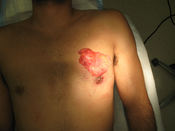What is Gynecomastia?
Definition
Gynecomastia is a common disease of the male breast where there is a benign glandular enlargement of that breast at some time in the male's life. It usually consists of the appearance of a flat pad of glandular tissue beneath a nipple which becomes tender at the same time. The development may be unilateral or bilateral. There is rarely a continued growth of the breast tissue; ordinarily the process is of brief duration and stops short of the production of permanent enlargement of the breast.
Causes
A great number of patients who suffer from this disease have a disturbance in the proper ratio of androgen and estrogen levels. The normal ratio of the two hormones in plasma is approximately 100:1. "The etiology of gynecomastia in patients with a known documented cause appears to be related to increased estrogen stimulation, decreased testosterone levels, or some alteration of the estrogens and androgen so that the androgen-estrogen ratio is decreased"(Williams 373).
From this information it was discovered that there is also a lower ratio of weaker adrenal androgens (delta 4-androstenedione and dehydroepiandrosterone) found in youths with this disease. It was once believed that there was an imbalance in the ratios of testosterone to estrogen or estradiol, but this is now know to be untrue.
There are three areas the can be attributed to the cause of gynecomastia: physiologic, pathologic and pharmacologic. "Enlargement of the male breast can be a normal physiologic phenomenon at certain stages of life or the result of several pathologic states."(Isselbacher, 2037)
In the case of physiologic gynecomastia the disease can occur in a newborn baby, at puberty or at any time in a man's life. In the newborn, transient enlargement of the breast is due to the action of maternal and/or placental estrogens. The enlargement...


